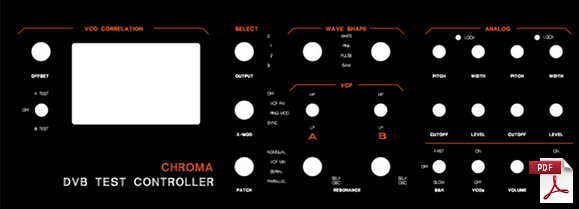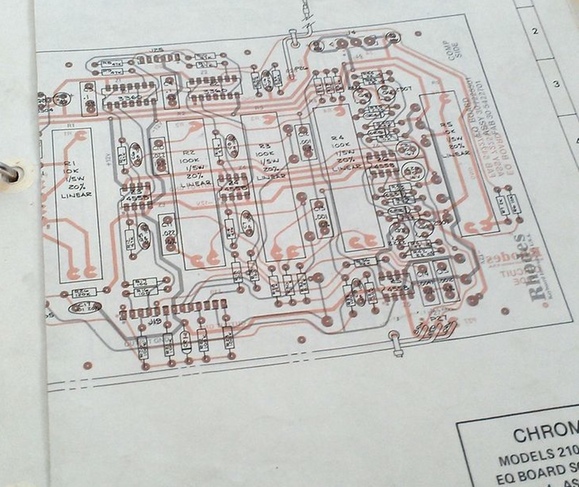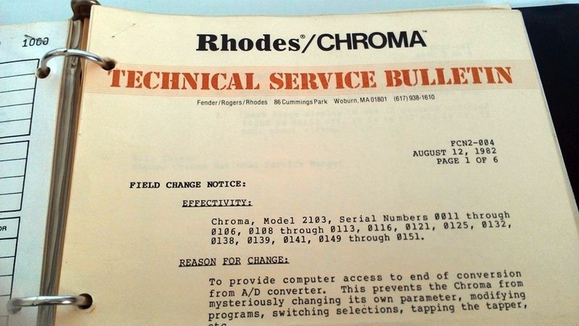ChromaTalk Archives: January 2012
- CC+ Firmware hiccup - entering 'config mode' with a high 'safe mode' program and pressing "P1" (4 messages)
- Re: Threshold Pressure (was "Question on the Poly Aftertouch / Pressure Sensor Kit Installation")
- How does the control panel work? (12)
- Chroma Brochure (7)
- Voice Board Test Controller (22)
- To Chris Borman: Op amps... (4)
- Voice board passes autotune, but isn't IN tune? (16)
- Do I have this straight? The expander basically makes a four oscillator voice? (4)
- Service and Programming Manuals on eBay (2)
- Polaris on Seattle Craigslist (2)
- greetings and help w/data jump -familiarization (12)
- Re: Chroma in Spain on eBay
- The new CPU+ and power supply (2)
- Manuals on eBay (2)
- Chroma 21030360 on eBay (4)
- Chroma Keyboard Repairs (5)
- CC+ CODE FOR PRESSURE SENSING BEHAVIOR (8)
- Re: Sequencer Manual on eBay
- New Chroma Composition using Set/Split 38 (5)
- Possible Chroma issue (4)
- Transformer Board Assembly on eBay (5)
- Chroma for sale in Boston area (2)
- Last of the CPS Kits (5)
CC+ Firmware hiccup - entering 'config mode' with a high 'safe mode' program and pressing "P1"
David Clarke [21030085++] · Sun, 01 Jan 2012 16:16:03 -0500
An undesired behaviour in the Config Mode operation of the CC+ firmware has been identified.
Problem:
- You can cause a Chroma reset (causing an auto-tune) or a hang (requiring you to power-cycle), depending on what settings are in place before entering the mode - and which parameter in the config mode is selected first.
How the Issue is Seen:
- You have chosen programs from the front panel so that a program number greater than 25 (or 26, for newer firmware) is resident in the Chroma's 'safe buffer'; and
- You've entered CC+ Configuration Mode [Set Split][36]; and
- Before pressing any other buttons in configuration mode, you re-select P1.
How to Avoid the Issue:
- Make sure a program number <= 25 is in the safe buffer before going into Config Mode (not really that practical for most of us).
- Don't reselect P1 upon entry to Config Mode. P1 comes up by default, so you don't need to re-select it.
Impact:
- If the hang/reset occurs, it is recommended to re-check/re-set your configuration settings to ensure they're still set as you intend them to be.
Notes:
- This behaviour has been present in all firmware releases in at least the last 3 years, so if you haven't already seen it in your normal way of using the Chroma, you likely won't.
(The intent will be to address this in a future firmware release.)
David Clarke [21030085++] · Sun, 29 Jan 2012 01:20:35 -0500
An undesired behaviour in the Channel Pressure mode of MIDI transmit operation of the CC+ firmware has been identified.
Problem:
- You can cause a Chroma reset if a channel pressure message is transmitted via CC+ MIDI for a Link Channel.
How the Issue is Seen:
- CC+ Firmware 215 is installed [Set Split 36]+[P25] = 215
- CC+ Pressure Transmit is turned on [Set Split 36]+[P26] = ON
- CC+ MIDI Pressure Mode is set to Channel [Set Split 36]+[P16] = Chnl
- Current program has a "Link" set
- A key is pressed such that the 'Link' plays.
- A pressure message occurs for the Link program.
- For those users with a Pressure Sensor installed, channel pressure messages for a Link program can not be sent via CC+ MIDI.
- This issue does not affect the receipt of Channel Pressure Messages, nor does it impact usage of the system if CC+ MIDI Pressure Transmit is not enabled.
Notes:
- The transmission of Channel Pressure messages was only added in firmware release 215 - thus this issue would only apply to users with firmware 215 and pressure enabled.
As there is no specific way for a user wanting to transmit Channel Pressure for a patch with a link to work around this behaviour, this issue will be updated with a firmware update in the next few days.
August B. Raring [21010148] · Sun, 29 Jan 2012 17:20:16 +0100
Hello David,
thank you very much for this info, because I just wanted to update the firmware to 2.15 !
Chris Ryan [21030691] · Sun, 29 Jan 2012 08:52:53 -0800
On 28/01/2012, at 10:20 PM, David Clarke wrote:
As there is no specific way for a user wanting to transmit Channel Pressure for a patch with a link to work around this behaviour, this issue will be updated with a firmware update in the next few days.
CPU Plus firmware revision 216 has been posted.
Re: Threshold Pressure (was "Question on the Poly Aftertouch / Pressure Sensor Kit Installation")
Go to first message in thread, December 2011
Brian McCully [21030361] · Tue, 3 Jan 2012 18:54:36 -0800
Just catching up on recent threads. My latest CPS is holding together well, I'm very happy (yay!) to report.
There is definitely variability across the whole set of the p-sensors. I have (only) one note I almost literally have to stand on to trigger, whereas all the others function ok (with medium to easy pressure), but definitely not with the same sensitivity (I don't think finger strength is the issue, at all). I have removed all the green felts under the keys.
I'd be curious to know if the firmware could somehow aid in making all of the aftertouch sensitivities more uniform, via holding a user-storable table for minimum threshold / max value (similar to the outgoing MIDI key velocity offset issue), or just have a threshold setting per key?
I haven't had the chance to trigger external devices yet with poly pressure (or mono AT, now that I think about it) but am considering setting up a user table inside Cycling74's MAX to adjust for the differences between outgoing MIDI key pressure(s) if necessary. A stand-alone MAX applette could possibly be constructed to deal with the various poly or channel pressure issues via Local off and thru-put (back in).
Does anyone have a PC version of MAX (version 4.5 or higher)? I only have a Mac version and would like to share testing any stand-alone applettes for PC's (because I don't think I can create the PC stand-alone from a Mac). Another back burner project is a generic Chroma editor (or to start, at least a visual reference of all those bit-mapped parameter values), and I'd like to be able to provide a PC version of it.
Matrix [21030220] mentions in another post about the CPS sensor strip being short on one side with the alignment of the sensor strip to the keys (I think I've questioned this too, but it may have been a direct note to Chris B [21030194+]). It should be ok if all the keys are triggering aftertouch in somewhat of a uniform "across the board" manner, post-install. But if not, it's possible to slightly shift the damper bar in a left or right fashion to center the sensors - I needed to because of my initial backwards installation.
How does the control panel work?
Doug Wellington [21030300] · Tue, 03 Jan 2012 20:11:52 -0700
OK, I'm probably just too impatient, but I couldn't find this info online yet. How does the front panel on the Chroma work? When I touch the front panel, am I pushing two contacts together? I feel a small depression under each "button", so is there some kind of conductor on the back of the front panel that gets pushed down to make contact with a lower layer? I've been hesitant to peel off the front panel to figure it out...
Somewhat related, has anyone had new panel labels printed?
Paul DeRocco [21030230] · Tue, 3 Jan 2012 20:06:45 -0800
OK, I'm probably just too impatient, but I couldn't find this info online yet. How does the front panel on the Chroma work? When I touch the front panel, am I pushing two contacts together? I feel a small depression under each "button", so is there some kind of conductor on the back of the front panel that gets pushed down to make contact with a lower layer? I've been hesitant to peel off the front panel to figure it out...
Don't peel it apart or you'll probably ruin it.
They're conventional membrane switches, of the simplest sort. Four layers of Mylar, a graphics layer, a top circuit layer with silver ink screened on the underside, a spacer layer with holes in it, and a bottom circuit layer with silver ink screened on the top. The two circuit layers have tails which plug into the ZIF connectors on the I/O board. The circuit layers have large silver ink patches at each switch location which touch each other when you press on it, and the switches are arranged in an X-Y matrix which is scanned by the CPU.
Somewhat related, has anyone had new panel labels printed?
For what reason?
Doug Wellington [21030300] · Tue, 03 Jan 2012 23:09:15 -0700
Hiya Paul,
Don't peel it apart or you'll probably ruin it.
That's what I was afraid of. Thanks for the info...
For what reason?
Nobody has ever damaged a front panel? (Here's hoping!) I also remember seeing a different color scheme somewhere. And, well, I was contemplating how hard it would be to recreate the front panel...
Chris Ryan [21030691] · Tue, 3 Jan 2012 22:23:29 -0800
Nobody has ever damaged a front panel? (Here's hoping!) I also remember seeing a different color scheme somewhere.
See my overview Panel Colour Themes.
Paul DeRocco [21030230] · Wed, 4 Jan 2012 09:51:00 -0800
Nobody has ever damaged a front panel? (Here's hoping!) I also remember seeing a different color scheme somewhere. And, well, I was contemplating how hard it would be to recreate the front panel...
I doubt it's possible even to remove the existing top graphics layer safely, because the adhesives are quite strong, and it would probably delaminate the layers below it in places, perhaps damaging them. And you can't get replacements for the entire assemblies. I'm making some for the Polaris, because they all fail, but no one is likely to do that for the Chroma, since the tooling would be too expensive to make just a few.
If all you wanted to do was to add an overlay, you could probably make one by printing on the back of an appropriately textured sheet of Mylar with an inkjet printer. Then you'd probably have to back that with enough solid black (or perhaps white) ink to make it opaque to the old graphics you'd be overlaying. But even with very thin Mylar, it would increase the force needed to activate the switches.
Ron Joseph [21030042+] · Wed, 4 Jan 2012 18:00:47 +0000
Is it possible to repair the ribbon ends on the panel membranes; I have two Halloween panels that have issues. I saw that someone did a repair of a Polaris with a similar issue but it looked iffy as well as difficult...any ideas?
Paul DeRocco [21030230] · Wed, 4 Jan 2012 11:45:27 -0800
I don't know that there's really any similarity between the two, because the Polaris has the peculiar problem of the tails cracking and disintegrating, and also has some green "protective" stuff that has to be scraped off in order to expose new contact areas. I've not heard of the same sort of cracking on the Chroma, and the silver is exposed all the way down the tails, so it ought to be a simple matter of just chopping off the damaged part of the tails. If the silver itself has cracked and has discontinuities, it still ought to be possible to paint fresh silver or carbon loaded ink over the crack, if you can find some somewhere. As long as the Mylar isn't crumbling, it shouldn't be hard to fix.
Russ Lyons [21030574] · Wed, 4 Jan 2012 14:47:09 -0500
I peeled the whole patch/param section of the overlay off of a Chroma, drilled holes through the aluminum panel, mounted microswitches under each membrane button and hardwired the matrix to the I/O board. Then I glued the overlay back down over the swiss cheese. It did work well after that, but I was younger and am wiser now.
See Attention Russ Lyons - questions relating to Chroma panel repair, June 2012
Paul DeRocco [21030230] · Wed, 4 Jan 2012 11:55:32 -0800
Of course, in that case you no longer care if the membrane switches actually work.
Has anyone else had (or heard of) failed membrane panels on the Chroma?
John Leimseider [21030434++] · Wed, 4 Jan 2012 12:52:25 -0700
I've had to replace about 1/2 a dozen over the years... I still have a couple of spares...
Paul DeRocco [21030230] · Wed, 4 Jan 2012 12:12:46 -0800
What fails on them? Is it surface damage (e.g., cigarette burns), cracks in the individual switches, or tail failures? If the last, do they crumble like Polaris tails, or get injured somehow?
John Leimseider [21030434++] · Wed, 4 Jan 2012 13:07:22 -0700
I saw a group of switches, but not a full row or column, fail. In other words, traces broke inside... they didn't seem to have any external damage. I worked on LOTS of Chromas, including when they were under warranty.
Chroma Brochure
Matrix [21030220] · Tue, 3 Jan 2012 20:48:50 -0800
[eBay item #280801028896]
Not mine. Thought I'd forward it along to anyone that might be interested.

Matrix [21030220] · Tue, 3 Jan 2012 20:49:57 -0800
And a Polaris.
[eBay item #280801029620]
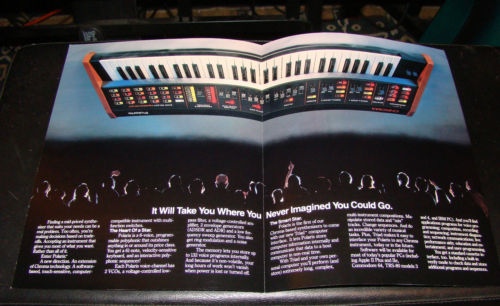
Chris Ryan [21030691] · Mon, 9 Jan 2012 00:18:57 -0800
Sold for USD$31.00 and $$8.50, respectively: see Price History and Polaris Price History. Note that scans are available on the site: see Chroma Brochure and Polaris Advertisements: Pre-Production Ad. See also Panel Colour Themes: The Polaris Prototype.
Marais · Mon, 9 Jan 2012 19:36:36 -0500
Request. Any chance we could have these as PDF's one day that would be wonderful. Same with the manuals. They're a bit clumsy in this format but perhaps that's intentional?
Chris Ryan [21030691] · Mon, 9 Jan 2012 19:47:02 -0800
Definitely not intentional: my assumption is that hypertext—I have spent a lot of effort providing links between and among the different sections and subsections of the manuals—is a better format than print. Some have asked for PDFs from time to time, and I've played around with combining the component sections of the manuals (Performance, Expander Performance, Programming, Service, Interface, Polaris Service) into optional single web pages, which I still may do at some point. Of course you can create PDFs of the existing pages very easily (at least on Mac OS X; it used to be the case on Windows that you needed to buy Adobe Acrobat but I think this might have changed as of Windows 7); the site has a print style sheet that drops the navigation. So you can even print them directly. Voilà.
That said, there are scans of some of the manuals available in PDF format: see Manuals.
And, just for you, I have created and posted a PDF version of the Brochure.
Marais · Wed, 11 Jan 2012 07:54:09 -0500
any chance of getting the ads in separate PDF's. I would like to print and frame them. Thank you.
Chris Ryan [21030691] · Wed, 11 Jan 2012 07:43:54 -0800
Printing the graphic files would give you the same result: in fact a PDF would probably have some additional lossy compression on it.
Voice Board Test Controller
Luca Sasdelli [21010226] · Sat, 07 Jan 2012 09:14:09 +0100
Hi all and happy new year!
A few days ago I've completed a DVB Test Controller: because of Dave Wilson's one available informations are quite few, I've sent to Chris a description and some pictures, to help those intended in building one.
I'm already using the Test Controller to repair some voice boards and I can say that it's a valuable tool, covering all function checks needed for it.
Thanks again to Chris Ryan [21030691] for his kindly support in making the infos available and creating the website sections.
Chris Borman [21030194+] · Sat, 7 Jan 2012 18:03:02 -0500
Great Job Luca!
Doug Wellington [21030300] · Sat, 07 Jan 2012 16:19:04 -0700
Hiya Luca,
Hi all and happy new year!
And happy new year to you!
A few days ago I've completed a DVB Test Controller: because of the Dave Wilson' one available informations are quite few, I've sent to Chris a description and some pictures, to help those intended in building one.
That's fantastic, thanks! I was thinking about building something like this to test my voice board design...
Werner Schöenenberger [21010114] · Sun, 8 Jan 2012 08:43:18 +0100
Wow, Luca I am impressed. Congratulations.
Luca Sasdelli [21010226] · Sun, 08 Jan 2012 10:11:37 +0100
Thanks Werner and all,
indeed I've bought [made] the Test Controller to help myself during repairing and, because it's quite unusual matter to me (half of the box is made by wires!) I wanted to publish to encourage its building, for those interested. Its operation is very simple, it addresses straight each DVB section and helps a lot in finding out what's wrong. And my Chroma is away from stresses :)
It could be made even simpler to build, by using some logic instead of switches to manage it, but it would be a complicated matter to achieve it.
Luca Sasdelli [21010226] · Sun, 08 Jan 2012 19:21:43 +0100
Sorry,
I've "made" the Test Controller, not "bought" :) (...languages, languages...!)
Eric W. Mattei [21030443+] · Sun, 08 Jan 2012 10:39:57 -0800
Your English is better than my Italian! ;)
Luca Sasdelli [21010226] · Sat, 21 Jan 2012 12:23:40 +0100
Hi All,
it seems that since publication of the Test Controller article, there is some interest around in building this tool; I'm still using the prototype and it works very well.
As written per above, most of the Test Controller assembly work is on wiring and some mechanics, therefore I'd like to know if some users are interested almost in a PCB that can collect most of the electronics, so that the assembly work could rely only in switch wirings and case metalwork.
The PCB I'm thinking about would include:
- test board connectors
- all logics
- diode matrix
- noise generator and filter
- audio output buffer
- power supply (excl. power transformer)
- correlation meter circuitry (*see below)
If such as a PCB would be available as pre-assembled, the Test Controller should be obtained with:
- metal case and relevant work
- power transformer
- switches & wirings
- potentiometers
- output jack
- center-zero meter (*see below)
All controls are mounted with the front panel as a guide: a single piece costs Euro 87,00; the panel manufacturer has these quantity discounts:
- 5 to 9 pcs 10% (Euro 79,00)
- 10 to 19 pcs 20% (Euro 70,00)
- 20 to 29 pcs 30% (Euro 61,00)
I don't know the PCB cost yet: if some users will adhere to this request, I can begin in drawing it and to see costs. The PCB should be provided either as pre-assembled or PCB only, to gain the highest quantity and consequent discount from the PCB makers.
*P.S.: I'm currently experimenting a VCO correlation meter, to track VCO frequency curve in respect to control voltage; this to predict if the VCO would pass the auto-tune or not. The circuit uses the same Exar' XR4151 as per the Chroma VCO, configured as Frequency-to-Voltage converter, plus a differential amp and some zeroing voltage summing, and drives a center-zero ammeter. Should it work as expected, the PCB would include this too and the front panel would have the meter area too (a suitable and easy to find instrument should be chosen, or even an LED bar, depending from the results I'll get from tests).
Arun Majumdar [21030348] · Sat, 21 Jan 2012 13:29:15 -0500
I am interested - I think it is a great idea :)
John Leimseider [21030434++] · Sat, 21 Jan 2012 17:44:58 -0700
I'm interested too. It will make the relatively easy fixes even easier. I still have a couple of cards that pass autotune, but that have one oscillator that is more out of tune than it should be. Any input on this problem would be welcomed. I have about 8 voice boards that are ready for sale. They are all fixed and tested.
Paul DeRocco [21030230] · Sat, 21 Jan 2012 19:10:23 -0800
I still have a couple of cards that pass autotune, but that have one oscillator that is more out of tune than it should be. Any input on this problem would be welcomed.
One thing that can cause this is a leaky sample-and-hold. This results in a little 50Hz sawtooth on what should be a flat signal. Since the autotune runs the sample-and-holds at a different rate, the amplitude of this sawtooth, and hence the average offset it represents, is different between autotune and regular playing. You can see this with an AC coupled scope set to a low range, and you might even be able to hear it with a cap coupled audio cable touched to the sample-and-hold output.
Jeffrey D. McEachin [21030073+] · Sat, 21 Jan 2012 17:13:37 -0800
I'd buy one!
Paul DeRocco [21030230] · Sun, 22 Jan 2012 18:52:34 -0800
Other than the frequency to voltage converter, what will this controller do that a functioning Chroma won't do? I've always worked on my bad boards by plugging each one into a Chroma with the other seven boards removed, and then using SS31 to activate it. An extender board might be nice, so that the board could be made more accessible.
Arun Majumdar [21030348] · Sun, 22 Jan 2012 21:59:12 -0600
Hi,
I imagine the that advantages are:
- Easy access;
- If you have accidentally created a short-circuit, then you don't damage anything else (of course if you are using a switching supply with short-circuit protection this is less of a problem but can be disaster with the original linear supply).
- You don't have to take out the rest of the boards, just the faulty one, saving space and mechanical wear;
- If you're designing a replacement board i.e. a plug in discrete replacement to the 3350 or 3360, then you will need one of these
- If you have a dead Chroma, then you have no motherboard to use to test if the boards are good or not, unless, of course, you own *two* working Chroma's
I would definitely buy Test Controller.
Luca Sasdelli [21010226] · Mon, 23 Jan 2012 09:14:40 +0100
Il 23/01/12 03.52, Paul D. DeRocco ha scritto:
Other than the frequency to voltage converter, what will this controller do that a functioning Chroma won't do? I've always worked on my bad boards by plugging each one into a Chroma with the other seven boards removed, and then using SS31 to activate it. An extender board might be nice, so that the board could be made more accessible. Hi Paul,
by the usage I'm experiencing right now, and with my personal feeling in troubleshooting, the Test Controller offers a quick access to analog parameters without having to play with the keyboard or the data slider, testing VCOs, VCFs and VCAs across their entire working range; it is nice when some irregular waveshapes exhibit overshoots or some distortion at given frequencies, or when the VCF autooscillation isn't that linear as it should be. The S&H functionality is as well more immediate and detailed than the working Chroma one.
Of course it should be of interest to those having some other's Chroma DVBs to repair, and not only as an accessory for the own instrument.
The extender board would be a useful idea: some time ago I was considering to build four 8-pin flat flex cables, to allow the failed board to lay somewhere over the instrument, making it much more accessible for measures and avoiding too many pull-outs/pull-ins.
Norman Fay · Mon, 23 Jan 2012 11:38:49 +0000
I would certainly be interested in one of these.
Werner Schöenenberger [21010114] · Mon, 23 Jan 2012 19:47:41 +0100
Hi Luca,
please take me on the list as well. Thanx.
RJ Krohn [21030455] · Mon, 23 Jan 2012 16:36:25 -0700
i'm just gonna throw this out there: this seems like the kind of thing that i would be interested in renting from someone in the future, as opposed to building. something to consider for those interested in building, maybe?
Luca Sasdelli [21010226] · Tue, 24 Jan 2012 09:15:59 +0100
i'm just gonna throw this out there: this seems like the kind of thing that i would be interested in renting from someone in the future, as opposed to building. something to consider for those interested in building, maybe?
This is interesting too. For sure I'll have to build a second one to test the new PCB, therefore I'll have one spare. We'll think about.
In the meantime, I'm going to finish the first PCB draft, so I guess having some pricing defined in a couple of weeks or so.
Frank McGing [21010198] · Tue, 24 Jan 2012 12:39:26 +0100
I'm with rj on this one, and I think it's a great idea. I have one faulty DVB, but managed to pick up a spare that's working properly in my Chroma. However, at some point I'm pretty sure I will have a problem with one of the DVBs, and it would be great to have the temporary use of a DVB test controller. But not worthwhile for me as a building project in case I need to fix one DVB!
John Leimseider [21030434++] · Tue, 24 Jan 2012 16:15:02 -0700
Me too!
Odysséas Tsakas-Grigoriadis [21010242] · Tue, 24 Jan 2012 23:39:08 +0000
Hi Luca, Count me in please,
Thanks!
To Chris Borman: Op amps...
Doug Wellington [21030300] · Sat, 07 Jan 2012 16:16:29 -0700
To Chris Borman [21030194+],
I got a bounced email message saying that comcast had blocked my ISP (GoDaddy, go figure...) because of SPAM. Figured I'd just post this here instead since other people might be interested. Hope you don't mind.
Randall swapped a few OP AMPS in the EQ board that I though really opened up the sound.
There are several 4558 op amps listed in the bill of materials. I wonder if those are the ones he swapped... I use the 4558 in the MB-808, the Roland TR-808 clone. They sound great there, but they aren't as clear sounding as something like a TL072 or TL082 or one of the newer OPA chips. If we use IC sockets on the PCB, we can test different op amps to see how they sound...
Chris Borman [21030194+] · Sat, 7 Jan 2012 18:36:19 -0500
What! Chroma is considered spam? No way!! Not a problem at all Doug. Can't find Randall's Chroma mod website were he had the EQ board mod. Maybe Randall can update us?
Chris Ryan [21030691] · Sat, 7 Jan 2012 15:44:44 -0800
Do you mean Randel Osborne's [21030467] On the Bench: Rhodes Chroma 3, in which he "replaced 4 operational amplifiers in the audio path of [his] Chroma with Analog Devices AD712 parts"? This (along with Randel's other articles) is linked from the Technical section page at the site.
Chris Borman [21030194+] · Sat, 7 Jan 2012 19:21:13 -0500
That’s it. Thanks Chris!
Go to next message in thread, February 2012
Voice board passes autotune, but isn't IN tune?
RJ Krohn [21030455] · Sat, 07 Jan 2012 16:43:17 -0700
hi all, happy new year! so i am having a bizarre experience: one of my voice cards passes autotune, but when triggered, the pitch will start noticeably flat, and drift up to—and past—its proper pitch. i was able to reproduce this drift in a manner in which it seemed to track the decay of one of the envelopes. so it would drift faster or slower, according to the decay setting. it will do it EVERY time its triggered, and only this once voice.
i recently re-seated two voice cards that JL [21030434++] had kindly troubleshooted for me. i foolishly assembled the synth again, seeing that it VISUALLY passed autotune, so i'm not sure yet which voice it is, but i will disassemble soon to confirm which voice is doing this.
have any of you seen this? any ideas as to a culprit on the offending board? thanks, rj
David Clarke [21030085++] · Sat, 07 Jan 2012 19:03:43 -0500
... im not sure yet which voice it is, but i will disassemble soon to confirm which voice is doing this...
If you're running a Chroma with a CC+ installed, then you can enable voice-watch mode by pressing [Set Split][37]. This should allow you to identify which voice is sounding when the bad behaviour is heard.
Paul DeRocco [21030230] · Sat, 7 Jan 2012 18:22:06 -0800
hi all, happy new year! so i am having a bizarre experience: one of my voice cards passes autotune, but when triggered, the pitch will start noticeably flat, and drift up to-and past-its proper pitch. i was able to reproduce this drift in a manner in which it seemed to track the decay of one of the envelopes. so it would drift faster or slower, according to the decay setting. it will do it EVERY time its triggered, and only this once voice.
The most likely culprit is leakage in one of the sample-and-hold circuits, in your case between the pitch control voltage and either the filter tuning or volume control voltage. Since the control voltages are refreshed at about 50Hz, any pulling of this sort results in a small 50Hz sawtooth on the control voltage, which you can easily find with a scope. If you don't have a scope, you could probably listen to the output of each S&H through a small capacitor. It could be caused by a bad capacitor, a bad 4051, or a bad TL082 opamp. It could even be contamination on the board.
RJ Krohn [21030455] · Sat, 07 Jan 2012 19:56:17 -0700
thanks david! this was super helpful. i was able to not only easily identify the VB, but trimming it up seemed to do the trick (not "bending" in pitch anymore. strange.)
so this leads me to another question: after going into set split 50, then in set split 37 mode, i noticed it would be really easy to touch up all of the oscillators that are just slightly off. while all my cards pass the autotune function, i notice that some have slight beating. it seems like i could just tighten up the tuning on the handful of them that are a few cents off while im at it. is there anything i should be cautious of if i do this? bad idea for any reason?
Paul DeRocco [21030230] · Sat, 7 Jan 2012 19:07:03 -0800
thanks david! this was super helpful. i was able to not only easily identify the VB, but trimming it up seemed to do the trick(not "bending" in pitch anymore. strange.)
I'm not sure why trimming anything would fix the problem, but you can't argue with success.
so this leads me to another question: after going into set split 50, then in set split 37 mode, i noticed it would be really easy to touch up all of the oscillators that are just slightly off. while all my cards pass the autotune function, i notice that some have slight beating. it seems like i could just tighten up the tuning on the handful of them that are a few cents off while im at it. is there anything i should be cautious of if i do this? bad idea for any reason?
The tuning will always be a bit uneven because the DAC has limited resolution. You'll never get the Chroma to be really tightly tuned.
Doug Terrebonne [21030114] · Sat, 7 Jan 2012 21:44:04 -0800
The tuning will always be a bit uneven because the DAC has limited resolution. You'll never get the Chroma to be really tightly tuned.
Which is one thing that makes an analog synth great... If you want perfect tuning use a DCO synth... :)
RJ Krohn [21030455] · Sun, 08 Jan 2012 10:55:10 -0700
oops-i did not solve my "envelope pitch" problem after all.
sorry folks, i mis-diagnosed. i had set up a diagnostic patch, and the lack of envelope settings must have caused it to SOUND in tune. however, when i started recalling patches with EG info, i realized the problem was not solved by tuning the card after all.
so, i am now quite confident the problem resides OFF of the VB in question. i sat a spare card in the same slot (#4) as the "faulty" one, and i got the same problem. so i'm now guessing its either the I/O board, or (most likely) the motherboard. it seems to be much more pronounced one the upper voice than the lower voice. does this sound like a known issue of any sort?
Paul DeRocco [21030230] · Sun, 8 Jan 2012 10:26:59 -0800
Re: oops-i did not solve my "envelope pitch" problem after all.
You should go a step further and put what you thought was a bad card into a different slot, and what you thought was a good card into the suspect slot, to see if the problem remains in that slot.
I can't imagine anything that could explain this except perhaps that a pin on the motherboard is bent down and not inserting into the connector on the voice board. But I would think that would result in nothing working right, not just a slight problem. It still sounds to me like classic sample-and-hold leakage, plus a mis-diagnosis.
RJ Krohn [21030455] · Sun, 08 Jan 2012 13:39:45 -0700
Re: oops-i did not solve my "envelope pitch" problem after all.
paul-you were exactly right. misdiagnosis:
so i had tried two separate voice boards(that passed autotune) in the same slot and got the same symptom. this led me to believe it had to be the slot. it wasnt. i actually, somehow, have two VB's that exhibit the same strange EG issue. i moved a KNOWN working card to #4, and sure enough, slot #4 now both passes autotune AND is in tune(enough to play a tune!).
so now i must focus on these three voice cards, all problematic. (i only need to get one of them working, two are spares). two of them exhibit this behavior of a EG1 affecting the pitch of OSC B. the third has a steady drone in pitch, and will not pass autotune at all. that VB test controller sure would be handy right now! :)
thanks for the help, folks. much obliged.
Paul DeRocco [21030230] · Sun, 8 Jan 2012 13:55:42 -0800
Re: oops-i did not solve my "envelope pitch" problem after all.
Did you get my earlier message? This shouldn't be too terribly hard to diagnose. It sounds like leakage between the PITCH B channel in the sample-and-hold and some other channel, rather than leakage to ground, so it's probably not a bad capacitor. It's more likely a bad 4051 (Z19 or Z20). It could even be contamination on the board between traces going to C28 or C36 (the PITCH B sample-and-hold caps) and some other adjacent trace. Or, conceivably the op-amp Z23, but that's less likely.
RJ Krohn [21030455] · Wed, 11 Jan 2012 12:48:44 -0700
think i'm all sorted. thanks folks
do while it sometimes means letting the machine warm up for a bit, and then turning it off and back on, i'm able to get all 8 voices in tune pretty regularly now. thanks to all for the help.
something i hadnt explored much before this week: sequencer mode on the keyboard parameter. pretty fun. there's probably no way to derive a BPM from the LFO rate, is there? it's a nice writing tool that's implemented in a way i've never seen on a synth. fun times...
Jesper Ödemark [21010135] · Wed, 11 Jan 2012 21:56:40 +0100
Re: think i'm all sorted. thanks folks
Borrow a beat counter from a DJ or count yourself. Scratch that down on paper and you know. Analogue indeed! :D
Paul DeRocco [21030230] · Wed, 11 Jan 2012 13:02:46 -0800
Re: think i'm all sorted. thanks folks
something i hadnt explored much before this week: sequencer mode on the keyboard parameter. pretty fun. there's probably no way to derive a BPM from the LFO rate, is there? it's a nice writing tool that's implemented in a way i've never seen on a synth. fun times...
The Chroma's timing for control signals isn't that precisely controlled, but I think you'll find the following list pretty close. It's based on the table that converts from sweep rate parameter values to phase increments, assuming a 50Hz update rate.
- 7.5
- 8.0
- 8.7
- 9.3
- 10.0
- 10.8
- 11.6
- 12.5
- 13.4
- 14.4
- 15.5
- 16.7
- 18.0
- 19.3
- 20.8
- 22.4
- 24.1
- 25.9
- 27.8
- 30.0
- 32.2
- 34.7
- 37.3
- 40.2
- 43.2
- 46.5
- 50.0
- 53.8
- 57.9
- 62.3
- 67.0
- 72.1
- 77.5
- 83.4
- 89.7
- 96.5
- 104
- 112
- 120
- 129
- 139
- 150
- 161
- 173
- 186
- 201
- 216
- 232
- 250
- 269
- 289
- 311
- 335
- 360
- 387
- 417
- 448
- 482
- 519
- 558
- 600
- 646
- 695
- 748
Do I have this straight? The expander basically makes a four oscillator voice?
Doug Wellington [21030300] · Sat, 07 Jan 2012 17:05:17 -0700
Do I understand correctly that the Chroma Expander doesn't increase polyphony?
Chris Ryan [21030691] · Sat, 7 Jan 2012 16:11:45 -0800
That is correct. See for instance Tony Williams' comment on this in the Dodds/Williams interview.
Doug Wellington [21030300] · Sat, 07 Jan 2012 17:31:35 -0700
Thanks for that. So, then, if I were to make another batch of voice cards that weren't exactly the same as the originals, and I put them in an expander, then I might end up with something interesting...
Dave Bradley [16330135] · Sat, 7 Jan 2012 18:32:10 -0600
Well, there is a way to cheat. I used to get 14 voices of polyphony, 7 on each side of a split. You just linked your patch to a monophonic silent voice, with the silent voice being linked lower on the expander and linked upper on the main chroma.
Service and Programming Manuals on eBay
Chris Ryan [21030691] · Tue, 10 Jan 2012 08:11:40 -0800
Item #300647766002, starting bid USD$39.99, no bids yet, ends January 12.
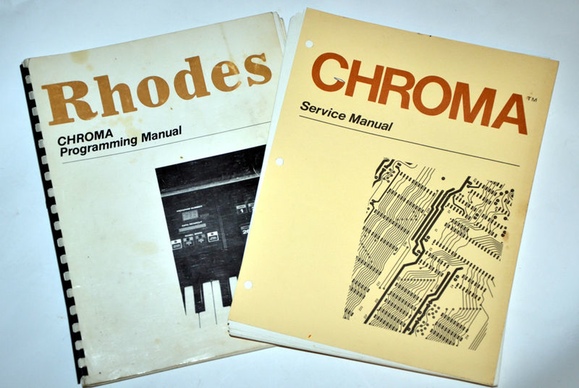
See Service Manual and Programming Manual.
Chris Ryan [21030691] · Mon, 16 Jan 2012 00:03:55 -0800
Sold for USD$47.00.
Polaris on Seattle Craigslist
Brian McCully [21030361] · Wed, 11 Jan 2012 19:52:35 -0800
VINTAGE RARE CHROMA POLARIS II SYNTH - $800 (Everett/Lynnwood/Seattle)
[Item 2790085558]
Not sure why it's called a Polaris II, but anyway it's been listed for a few weeks - don't know if anyone's interested on this list.
Chris Ryan [21030691] · Wed, 11 Jan 2012 19:56:32 -0800
Thanks, Brian. The Polaris II is model 2123B. See also Polaris Rev's, May 2003.
greetings and help w/data jump -familiarization
Robert Weigel [Polaris 300674++] · Sun, 15 Jan 2012 22:51:12 -0700
Hey gang, many of you may know me from sdiy or work on various instruments, videos on youtube etc. as sounddoctorin. I am working on my first CHROMA here in CT at 'For Musicians Only' studio. Nice gear here. Wes worked on the wood for this one. Absolutely beautiful piece of burled walnut.
Anyway to start with it's got some issue that is causing data to move so it thinks it's being edited.
I can't find the data slider on the diagrams. I combed it a few times. Does anyone know where it is off the top?
Second as it's varying the parameter currently saved as the default for the slider to edit *(assuming this is like some others where they allow your last edited parameter to become the default so you can do performance edits of your preferred thing quickly with the slider.)* I also hear pitch jumping around even when it's not a pitch parameter that was saved.
When I edit ... sometimes the display won't go to zero. Other times it's fine. It'll go to like 16 and jitter around from there. Though I'm moving it around. Quite strange. So I don't think it's just the slider which I cleaned of course for those reasons.
The power supply is a new switching supply. Measures +12 and -11.85V or like that.
Also this has the new cpu board. I'd love to get any help that would point me the right direction since I went over the diagrams twice or three times looking for the data slider already. lol
Leonardo Ascarrunz [no serial number] · Sun, 15 Jan 2012 22:55:21 -0700
Clean or replace the slider.
Paul DeRocco [21030230] · Sun, 15 Jan 2012 22:01:13 -0800
The A/D stuff runs off analog 5V. That's probably got noise or ripple on it. Could be a bad connection back to the power supply, but I know nothing about the replacement supply.
The slider is drawn on the left side of page two [I/O Board Schematic 2], between the +5V REF and RESET connector lines.
Robert Weigel [Polaris 300674++] · Mon, 16 Jan 2012 00:29:10 -0700
correction in that last post
I see the pages now that were disorganized with the i/o board. And the slider being one of several inputs on the 0809.
Now I'm trying to correlate what's making the difference here...** but Im not seeing it yet. But SOMETIMES you can select a patch and it won't show immediately the dot indicating something has been edited. Other times you punch the patch number and immediately it thinks an edit has taken place. But anyway THIS SEEMS it would be a clue. When I even lightly TOUCH a key...on the controller keyboard (oh yeah this is an Expander btw) then it immediately lights the dot indicating edit! It can set there many seconds after selecting the patch and consistently the dot comes on right after I barely touch a key even. Hope that helps clarify the issue. -
**(there's also a pop when I pivot the front panel up...but for the life of me I can't see what is touching anything and I can bring it near that angle where it usually does it and I can wiggle everything and...no pop...move the panel a little further and..POP).....
Paul DeRocco [21030230] · Sun, 15 Jan 2012 23:45:32 -0800
Re: correction in that last post
What's likely happening is that the input to the A/D is jittering, probably because the analog +5V is unstable. If you have a high-resolution (e.g., 0 to 63) parameter selected, it will almost certainly produce a change in the value. If you have a low-resolution parameter selected, and the position happens to match the current value, then the noise won't be enough to bump it to a new value.
This is the sort of thing that is easy to track down with a scope, hard to track down without a scope.
Robert Weigel [Polaris 300674++] · Mon, 16 Jan 2012 09:42:16 -0700
I should have noted Paul that I did see the note about the jittering values. In this particular case though like I say it was doing things like...hanging the value at 16 even though you're moving the slider at the bottom of it's run...then..next thing you know it would be smoothing varying from 0 to 32 I think it was in the case of the parameter it was set to at the time. I had my meter getting 5.05V all the time but haven't hooked a scope up to it yet as the probe hasn't gotten here yet. They were supposed to have a scope going for me. I rigged a piece of coax that will work for this at least though and i'll check.
Yup after I found the right diagram I saw that it's using the 5v reference. Have you ever seen the ssue where you hit a note at any level and it causes the dot to come on? I'd hate to lose my reputation of seeing a completely undocumented issue the first time I dig into an instrument. lol! I don't know why but it does seem to happen about every time. Partly because I wind up with a lot of things that others gave up on no doubt but it seems to go beyond that since it happens with my own stuff a lot too I think. Oh well always gives me something to add to the pile at the end :-)
Paul DeRocco [21030230] · Mon, 16 Jan 2012 09:41:18 -0800
I suppose there are lots of obscure failures that could result in flakey behavior like this, but the only thing I've ever seen that causes the parameter value to jump is ripple on the analog +5V supply. If that's not it, then you'll have a tougher time tracking it down. But I'd still probe around the A/D converter, and see if any of the voltages glitch at the moment you press a key, etc. This doesn't sound like anything you'll see with a meter, though.
Luca Sasdelli [21010226] · Mon, 16 Jan 2012 20:16:04 +0100
Hi Robert,
which switching PSU are you using? I've had some bad effects with certain switching models: perhaps too powerful and unable to keep the supply within narrow limits.
Tom Hughes [21030251+] · Mon, 16 Jan 2012 16:11:50 -0500
Hi Luca,
The Chroma Expander in Bob is referring to has a PSU I got from you a couple of years ago (May 2009, I think). It's a Rhodes Chroma Switching PSU MKII.
David Clarke [21030085++] · Mon, 16 Jan 2012 18:32:22 -0500
... Have you ever seen the ssue where you hit a note at any level and it causes the dot to come on? ...
The dot coming on simply means that 'something' has changed in the state of the current patch. That 'something' could be a voice parameter change (as might occur with the movement of the data slider), it could mean a control setting from the panel being changed, but it could also result from a data parameter being changed in another way or with a panel button being pressed.
Since this is an expander, and it is being triggered remotely, some consideration might be required to determined exactly 'what' is being sent to the card over MIDI. If the device is receiving CC data (for instance), then that could also turn the dot on. If that's the case, then the dot coming on in the presence of MIDI data might not be 'wrong'.
To simplify the setup it would be recommended to remove any external connection (e.g., MIDI). While you can't necessarily trigger any notes, you should be able to see if the odd slider behaviour/dot behaviour is still present.
As a debug step I'd recommend turning the panel tapper on, e.g.:
Now - you should hear the tapper fire every time a button is pressed. You should also hear it fire if the expander thinks the selected parameter has changed (assuming it is one of the parameters that doesn't have too many potential selections). This should at least help to understand what the Expander things is happening and how often it is happening (e.g., multiple triggers when you move the slider would be different than continuous firing of the tapper and different again from it unexpectedly firing every now and then.)
The earlier comment about the state of the slider itself is also important. While I've personally never seen a Chroma's data slider go 'bad', if the carbon element is overly dirty/cracked it might react erratically - sometimes allowing you to go to '0', other times not, etc. You should hopefully be able to 'see' that bad behaviour by watching the electrical values from the pot as it is moved (e.g., if the voltage into the slider is OK, is the voltage coming out of the slider OK?)
Heinz Weierhorst [21010276] · Tue, 17 Jan 2012 19:53:03 +0100
Hi Tom.
Did the two levers or the footpedals (Volume and Control) cause the same error? Did the battery display too? If so there is something wrong with the ADC, if not the Data entry pot is dirty or defective or the solder pads and connections should be observed. Is that plop in the audio chain i.e could you hear it in the speakers? In my Chroma was a broken contact in the connectors that causes that fault.
Robert Weigel [Polaris 300674++] · Tue, 17 Jan 2012 13:08:39 -0700
data jumping etc.
Fortunately he had a spare i/o board with what appears to be a good adc0809 . I installed it and after an initial weird boot left over from before perhaps?....(Does it recall the last edit buffer when it boots?) it's been PERFECT!
I see where someone had soldering a bit on a leg on that one and I bet in trying to correct a cracked leg issue they overheated the chip a bit. Thanks guys for some additional information on this marvelous piece. Really is a gorgeous unit with Wes' woodwork on it.
I was able to meet Randel Osborne today and hopefully we'll get to go over and see what he's doing at some point before I leave! Thanks again for all the helpful thoughts so far on this and great to hear from you again Dave and Paul.
Robert Weigel [Polaris 300674++] · Thu, 19 Jan 2012 14:12:45 -0700
First Chroma Adventure; what I learned and a question
We had 7 bad cards accumulated from a Chroma and Expander here at 'for Musician's only'. I think one of them wound up having the issue with the mux chips PLUS a broken interconnect.
I'd highly recommend using RV goop or something similar to hold the interconnects from moving as much. Some of them got bent back and actually cracked pins. I had to wire one of them since we didn't have any more. The power supply one which has doubling of lines fortunately :-). Only the ground was left hanging on with that one.
Another card had two bad 4151's and a bad op amp Z4 that I'd replaced with Z5 first thinking it surely would be one of the common elements rather than BOTH of the charge pumps!
Another has a bad CA3086 Z1. AND...all the yellow 1uF electrolytics used to couple the vcf outputs needed to be replaced along with one other below. Mostly just the ones there though...one would go very high esr and the other would be marginal or ok but I figured it best to replace all of those with highest quality ones.
So ONE issue remains hopefully after the 3046 chips arrives that we'll use for the 3086 since we also needed one for an octave cat.. this is strange..maybe somebody has seen this.
ONE card has a VCA that will hang. One side is working ok. The volume to the 33K resistor R75 from the S+H will maintain the highest velocity CV that you dish it. It only goes down if you ..turn it off...OR put a probe on the capacitor of the S+H. It then will diminish depending on probe impedence.
HENCE it would appear the 4051 which we've tried multiple new units in place of both.... is feeding current forward but it's not allowing it to be removed from the capacitor! Whhaaaa??? Anyone seen that one? I mean in that circuit we have two 4051's working together to pump the same voltages on..but one works all the time through the 1M resistors to give more gradual smooth changes, where the other is enabled by Z25's line to give an unhindered transfer of current to the capacitor from the common dac line.
So I'm a bit puzzled by that and thought maybe someone could lend a thought on it. I didn't install those chips so there's always a possibility of some problem under the socket however...I can't think of what on earth would cause it to behave this way. I mean there's no voltage just...leaking to it because it stays low til you hit a key! thoughts?
Technician Larry [21030198] · Thu, 19 Jan 2012 15:02:07 -0700
Re: First Chroma Adventure; what I learned and a question
Have you probed the HiZ buffer amp for some parasitic oscillation or some other clue as to very strange behaviour on the part of that chip? I agree - not much could go wrong - either something worng with the surface of the board or some issue with the buffer amp or a bunch of 4051s with the same failure mode - that would constitue a bad day for me.
Robert Weigel [Polaris 300674++] · Fri, 20 Jan 2012 11:16:42 -0700
Re: First Chroma Adventure; what I learned and a question
Ahhh...as I layed down to rest after working over a bunch of other stuff the thought hit me that the patch we were testing with MIGHT use the fast side to charge the cap and the slow to release it. hehe.. so I figured 1) an unlikely open 1M resistor or 2) more likely bad socket connection to it could cause such a phenomena...
Oddly though they all measured good when I woke up and my hopes were shattered :-)...however..I thought 'perhaps a bad address line that is causing the slow chip to not respond to only that parameter that we are noticing at the moment?
Bingo! pin 9 was open and we now have a working card! Thanks again for those offering helpful thoughts on this educational project for me. Hopefully will find one in need of help some day !
Re: Chroma in Spain on eBay
Go to first message in thread, December 2011
Chris Ryan [21030691] · Wed, 18 Jan 2012 07:59:43 -0800
Item #120835786585, starting bid USD$4,995.00, no bids yet, buy it for $6,000.00. No picture other than the centre spread from the product brochure and not much info posted: "Revised by MJ in LA [not sure who this might be], in excellent condition, comes with pedals, JL Cooper Chromaface w/ribbon cable (midi interface), and ATA flightcase." I've asked for more details.
Re-listed as item #120845408683, with the same details.
The new CPU+ and power supply
David Hobson [21030506] · Wed, 18 Jan 2012 22:35:03 -0500
Hello,
I am not new to the mailing list but I am new to understanding how to obtain the CPU+ and the new power supply. I am trying to get money together to get both and I would like to know how to proceed. And I will be the first to admit I am not the smartest kid on the block, so detailed info would be appreciated.
Thank you,
David Hobson
Chris Ryan [21030691] · Wed, 18 Jan 2012 19:41:54 -0800
Hi, David. See How Can I Get a CC+? and How Can I Get an SPSU Kit?.
Manuals on eBay
Chris Ryan [21030691] · Thu, 19 Jan 2012 08:30:45 -0800
Item #180799599817, USD$49.95, ends January 25. Looks to be the Service Manual, Service Bulletins (perhaps comprising Service Notes and Field Change Notices; FCN2-004 is shown), and Performance Manual. From the description: "Fender Rhodes Chroma Service manual, Technical guide and User Guide. Also fields many service bulletins and updates. It comes exactly as pictured, super fast shipping."
Pictures from the auction:
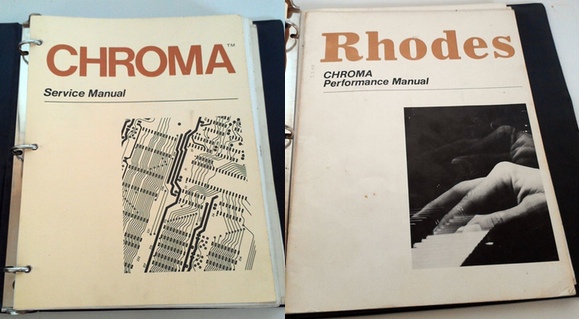
Chris Ryan [21030691] · Thu, 26 Jan 2012 21:11:32 -0800
Sold for USD$30.00.
Chroma 21030360 on eBay
Chris Ryan [21030691] · Fri, 20 Jan 2012 18:34:45 -0800
Item #280809578686, starting bid USD$5,000.00, ends January 29. This is Chroma 21030360, new to the registry. From the description:
"The electronics of this keyboard have just been replaced or refurbished, it has a new power supply that is switching ... 100v to 220v, also the tone generator boards have been replaced, the keys play fine and are in really good shape, it has MIDI but I can't get it to work, those 4 switches you see on the top left of the keyboard are for the MIDI, it's some combination of up/down to set the midi channel but i couldn't get it going.
"Cosmetically all the wood panels are in bad shape because of the foam in the case it was stored in for years. ... If you would like the wood panels refurbished I would recommend Bill Axman from Alltek Organ And Keyboard Service and after you pay then I would drop it [with] Bill and when it's done pick it up and send it to you, I'm not sure what Bill would charge for this but I'll find out."
I can't recall which MIDI retrofit might include the switches (Kenton? EES?); I'm not sure I've seen anything mounted at the top of the left panel like this. I've attached some pictures from the auction.
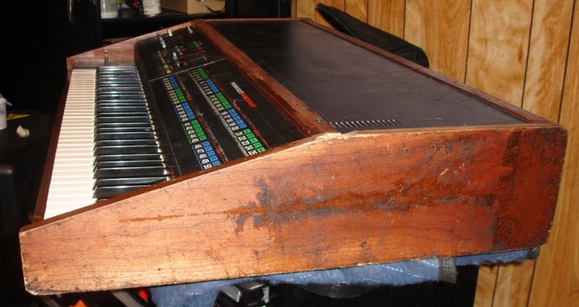
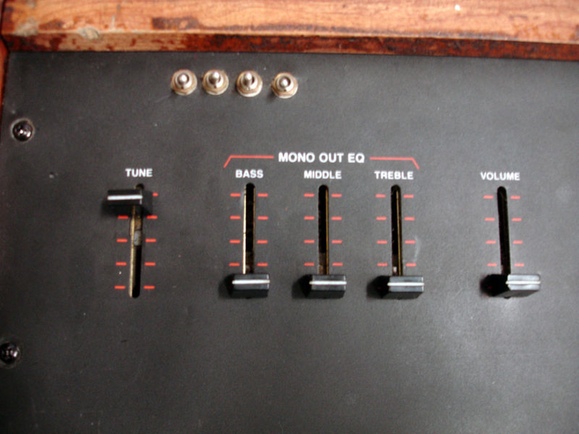

David Clarke [21030085++] · Fri, 20 Jan 2012 23:01:42 -0500
I can't recall which MIDI retrofit might include the switches (Kenton? EES?);
It's a bit tough to be sure without seeing inside the unit - but since it appears to be a North American unit, I'd guess it was probably the JL Cooper unit whereby the 4 MIDI address switches have been remoted out to the panel (e.g., switch 1-4 noted in the manual).
If the unit has a history overseas, I might guess it would be the EES Unit (which offers 4 switches too).
Chris Ryan [21030691] · Fri, 20 Jan 2012 20:02:49 -0800
Yes, maybe. I've asked the seller.
Andrew Dalebrook [21010180] · Sat, 21 Jan 2012 18:10:50 +1300
I bet the the switches are for 4-bit control over MIDI channel
Go to next message in thread, February 2012
Chroma Keyboard Repairs
Arun Majumdar [21030348] · Sat, 21 Jan 2012 00:26:32 -0500
I have finally started on updating my Rhodes Chroma's (both of them) and one is definitely much sicker than the other!
I just completed adding the SPSU kit and will likely get another at the end of the month. I had some adventures with all of that but the strangest thing is the issue with some keys sounding and other keys not working or working in a way that they leave a voice with what sounds like a long release, as if the pedal was pressed. This only happens to a few keys. Anyway, I am using some Isopropyl Alcohol to clean each and every key contact leaf using a narrow, moderately stiff bristled fine paint brush dipped in the alcohol. I am hoping that it is just dirty contacts -- it does not seem to be a mux board since more notes, in groups, should fail.
In addition, the other Chroma definitely has voice board issues and I am wondering if anyone knows how best to fix them at reasonable cost (email me)--- else I will have to build the Chroma board tester and go from there ... My biggest issue is my limited stock of CEM3360's - I think before I fitted the new power supply that the boards were starting to fail due to power issues (I had one board fail but I swapped from one Chroma to the other to get a full set working).
Any pointers on repairing the keys/keyboard are most welcome.
Paul DeRocco [21030230] · Fri, 20 Jan 2012 22:31:51 -0800
Unless you can discern a pattern, like a group of eight keys failing, or every eighth key failing, it's almost certainly dirty contacts. The only other per-key component is a resistor, and they're reliable.
I've found that keys generally self-clean if they are repeatedly played. However, if you need alcohol, another good way to clean them is to wet a strip of paper with it, insert it between the closed contacts, and slide it back and forth; insert it between the open contacts and press the key to clean them. That way you won't have to bend the contacts further than normal.
Chris Ryan [21030691] · Fri, 20 Jan 2012 22:48:40 -0800
Also, the FAQ points to a 2005 post by Vincent Russo [21030433] in which he describes a procedure outlined to him by a tech.
Arun Majumdar [21030348] · Sat, 21 Jan 2012 02:24:22 -0500
The keys finally dried out from the alcohol wash and I ended up with just two trouble keys remaining intermittent with a lingering sustain. The reason is that the middle leaf that gets pushed by the key does not return all the way *down* to make good contact with the lower leaf. The solution is to hold the middle leaf down to the key (very gently!!!) for a minute and try again. The difficulty in bending up the bottom leaf is that it naturally ends up bending up the middle leaf and so the problem tends to persist.
Now, all my keys are working perfectly :)
I really appreciate the input.
Arun Majumdar [21030348] · Sat, 21 Jan 2012 02:28:19 -0500
I followed the FAQ on this and found the guidance very useful. The only part that I differ with is that of bending either only the top or the bottom but not the middle. The idea is not to "bend" the leaves but more to restore them to where they should be resting and, the middle leaf is no exception. What happened with my keys that caused them to sound like sustaining notes is that the middle leaf did not make good contact with the lower leaf, so the choice was to bend up the lower, or re-adjust the middle leaf. Since the leaf has to return *down* after a key press which pushes it up to the top leaf, I found that very, very gently depressing and holding the middle leaf to the point where it touches the key for a minute or so was sufficient without needed to bend anything or ot bend up the lower leaf. This worked. I liked the faq reference as it got me thinking and exploring the keys.
CC+ CODE FOR PRESSURE SENSING BEHAVIOR
Arun Majumdar [21030348] · Sun, 22 Jan 2012 01:02:15 -0500
It would be great if we would add a delay *before* we start to sense pressure (to act to filter out the initial key strike pressure impulse). I am wondering if that can be done in software. Also I am burning in my new set of ROMS this weekend for the the new version 215 of the CC+ firmware and I thought it would be nice to have keyscales for various pressure/velocity settings types.
Any thoughts?
David Clarke [21030085++] · Sun, 22 Jan 2012 14:29:19 -0500
It would be great if we would add a delay *before* we start to sense pressure (to act to filter out the initial key strike pressure impulse)...
A couple notes:
-
The initial 'pressure' from a key strike comes from the key's velocity.
The keyboard scanning computer in the Chroma will detect when an attack or release event has occurred - and it will provide the 'time of flight' for that event to the main computer. The keyboard scanning computer does not actually know anything about pressure.
The original Chroma implementation is such that the initial pressure value for the 'attack' comes from a look-up table based on velocity to determine an initial pressure value. In most cases this won't matter too much as most of the slower strikes correspond to a pressure of zero. For faster key strikes though, the system will presume an initial pressure based on the velocity.
- It might be worth trying the pre-existing 'Pressure Threshold' modulation source vs. 'Pressure' to see how/if that addresses the 'initial key strike pressure impulse' desire. Specifically, this will work to gate off all lower pressure activity, and will require the user exceed a certain pressure value before any pressure manipulation occurs.
Arun Majumdar [21030348] · Sun, 22 Jan 2012 22:00:45 -0600
Hi David
I guess I should have made it a bit clearer.
When using the CPS poly pressure, which works really great, I noticed that the pressure "sensor" sends the pressure from the key strike to the modulation source (for example, pitch or filter) and this is heard immediately --- instead, it would be nice to *delay* the *initial* key pressure values only (actually, not to delay them but to filter them out).
So, it is not the velocity attack or release event but the actual poly-pressure sensor impact that I am trying to figure out.
All the rest works perfectly including the CPS, just that I would like to figure out if there is a way to delay sending pressure for some milliseconds to avoid the initial pressure sensing values.
Any thoughts would be most welcome!
Dave Bradley [16330135] · Sun, 22 Jan 2012 22:28:27 -0600
I believe he did answer your question, but you don't understand how Threshold Pressure works.
Arun Majumdar [21030348] · Sun, 22 Jan 2012 23:58:26 -0500
Cutting off the pressure values means that you *loose* all the lower pressure values when you depress the keys to get that modulation, and modulation only start for the remaining values above the threshold, which is not at all what I was trying to get. What I would like to get is to hit the key *hard* and then *gently* push to get the pressure modulation. The problem now is that I get the pressure kicking in when I hit hard: so, for example, with a patch that uses pressure to pitch, you end up with the squeal "impact" pressure from hitting each note, instead of being able to bring the pitch bends in over time with the note, and with hand playing technique.
I can solve it using an external controller and MAX/MSP by filtering out the first 20 milliseconds of pressure and applying a multiplier function (an exponential onto the midi stream values which is like a super-smooth fade in of pressure sensing). However, I would like to use the Chroma's own keyboard and that requires a key-response function to to filter out the first "n" user chosen milliseconds of pressure.
I hope that helps make it clearer.
Does threshold pressure work to introduce a delay or does it just cut off values below a parameter selected by the front panel slider via user choice? Looking forward to any clarification and help.
Thanks!
Chris Smalt [21010280+] · Mon, 23 Jan 2012 17:15:52 +0100
What I would like to get is to hit the key *hard* and then *gently* push to get the pressure modulation.
The trained pianist in me would say that, instead of hitting the key hard (with a lot of weight), you would simply hit it fast, and then gradually go "to the bottom".
David Clarke [21030085++] · Mon, 23 Jan 2012 21:59:05 -0500
... So, it is not the velocity attack or release event but the actual poly-pressure sensor impact that I am trying to figure out.
Just to clarify one of my earlier notes - the 'attack' message from the Chroma is actually expressed as a key, velocity and pressure (xref: the Chroma Interface Manual: Command Descriptions).
It is a 'feature' of the Chroma that the initial pressure response doesn't actually come from the pressure sensor - but it actually comes from the velocity response.
For instance - if you were to trigger a key with a velocity of 25 (on the Chroma's scale from 0->31), then - even without a pressure sensor - that initial 'attack' will have a pseudo pressure assigned to it on the basis of the velocity, and in this example would actually end up with an initial pressure of 16 (out of 63).
This may not affect MIDI messages (depending on the controller); however, it can affect what the Chroma does do for its internal voice generation.
To illustrate this (even on a board without a pressure sensor):
- Set up a scratch patch [manually or using the CPU Plus if you have it].
- Set Pitch Mod 3 Select (P31) to "14" (Pressure)
- Set Pitch Mod 3 Depth (P32) to "63"
Notice the difference in the initial pitch behaviour between a very hard (fast) strike and a soft (slow) strike.
This can also be used as a good demonstration of the Threshold Pressure setting. For the same test case above, set P31 to "15" (Threshold Pressure) instead of "14" (Pressure) and observe the difference in behaviour.
(I can only guess at the original design intent of the initial pressure being set by the velocity - but I would suppose it was to acknowledge the fact that if you hit the key fast enough to get a very high velocity then the natural throw of the key would be expected to impart a pressure 'hit', and this is a way to achieve that without the pressure sensor being expected to be able to respond instantaneously).
It doesn't actually impart a delay - but depending on the playing style, it could be used to delay when pressure starts to become active.... Does threshold pressure work to introduce a delay or does it just cut off values below a parameter selected by the front panel slider via user choice? Looking forward to any clarification and help.
Here's an excerpt from a list posting from December (Threshold Pressure):
"...Instead, the 'Threshold Pressure' mod source implementation ... works sort of like a ... 'low pressure cutoff'.
If the pressure asserted is less than half of the full value, then the pressure mod amount is "0" (e.g., pressure modulation is being done - but as if the pressure is '0'). If the pressure asserted is more than half of the full value, then pressure modulation is performed, with the 'pressure value' being half of what pressure would normally be pressed."
Arun Majumdar [21030348] · Mon, 23 Jan 2012 23:43:21 -0500
Hi,
This is an awesome explanation and I now I understand it, finally!!!
Thanks for everyone's help on this issue - I was confused but now I get it.
I will work my playing style with these bounds.
Re: Sequencer Manual on eBay
Go to first message in thread, December 2011
Chris Ryan [21030691] · Sun, 22 Jan 2012 18:41:00 -0800
This did sell, for USD$29.95; missed it at the time.
New Chroma Composition using Set/Split 38
Michael Dykehouse · Tue, 24 Jan 2012 20:28:41 -0500
Used only the Rhodes Chroma and Set/Split 38 for endless patch randomization, edited it down into this in Ableton Live (used some spring reverb and Max 4 Live panning weirdness as well). The Chroma RULES:) Sometimes feel like I should sell my euro set up and just use the Chroma.
The Genuinely Humble Nature Of My Genius (SoundCloud.com)
Arun Majumdar [21030348] · Wed, 25 Jan 2012 09:06:16 -0500
Hi --- this is super cool :)
Thank you for positing - it really does take one out into new inspirational areas: I had hardly ever used that function but thanks to you will now rediscover it!
Michael Dykehouse · Wed, 25 Jan 2012 09:29:49 -0800
Thanks Dave and Galaxiesmerge! It really was just an experiment but a fun one!. I usually write much more linear/melodic compositions but it's occasionally nice to throw spanners into the work and just pour some paint on the canvas! Would love to hear other what other Chroma owners using this technique can come up with! Next I will share a more melodic composition using only the Chroma. I LOVE THIS SYNTHESIZER SO MUCH! What an absolute joy, just to sit at this beauty and realize that a deep universe of pure analog joy lives inside! Sorry, I am a huge cornball!!! All the best and ChromaTalk is an amazing resource. Many thanks!
Christian Kleine [21030210] · Wed, 25 Jan 2012 15:55:04 +0100
Thanks! Very nice!
Tim Siefkes [21030850] · Thu, 26 Jan 2012 04:21:16 -0600
Enjoyed it very much, Michael. Very nice track.
Possible Chroma issue
MIchael Dykehouse · Wed, 25 Jan 2012 21:04:58 -0500
Hello and thanks beforehand for any help concerning my issue. It seems as though on every 8th note played the attack (on, let's say, a piano type patch) changes into a sort of a portamento-y, water drip type "thwop", slightly different then the previous seven that sound with the correct attack setting. This happens in cycles up and down the keyboard. Sound familiar? Easy fix or should I just live with it and or/ turn the offending voice off . Thanks again and all the best, Mike.
Paul DeRocco [21030230] · Wed, 25 Jan 2012 19:08:11 -0800
Probably a bad sample-and-hold on one board, most likely one of the 4051 analog switch chips. Not a hard fix for a technician.
Michael Dykehouse · Thu, 26 Jan 2012 09:15:52 -0800
Thanks Paul much appreciated. Anyone know of any reliable Chroma techs near Ann Arbor, Michigan? Again, thanks for your help.
Chris Ryan [21030691] · Thu, 26 Jan 2012 20:18:26 -0800
Anyone know of any reliable Chroma techs near Ann Arbor, Michigan?
See the Service Centres page at the site. This is a list of all the techs who have been mentioned or recommended to me or on the list over the years.
Transformer Board Assembly on eBay
Chris Ryan [21030691] · Thu, 26 Jan 2012 08:06:15 -0800
Item #180804078486, USD$69.95, ends February 1. Listed as part number 30-1226101, which doesn't seem to be included on the Parts List or Replacement Parts.
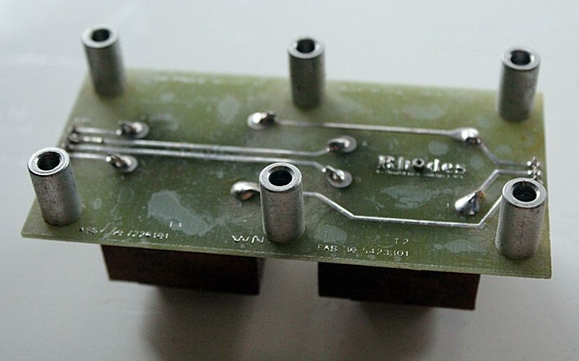
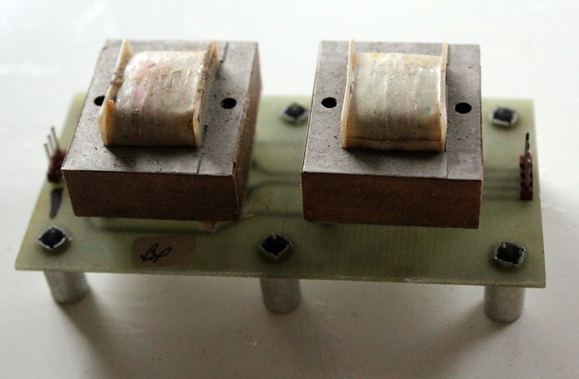
Paul DeRocco [21030230] · Thu, 26 Jan 2012 08:28:35 -0800
Not sure why it isn't listed. It's in the instrument. It's used for the XLR connector outputs. I seem to recall they were pretty high quality 600-ohm audio transformers.
David Clarke [21030085++] · Thu, 26 Jan 2012 18:42:01 -0500
Note: as I missed some of these auctions when they were active, I've included pictures here. — Chris
Although they have attributed it to the Fender Rhodes, I do believe the item listed here is also the one used in the Chroma: [eBay item #400065751659].

At about the same time the Transformer board was listed, there were also Chroma keys, stack switches and a channel mother board - all which sold pretty quickly:
Rhodes Chroma Complete Key Assembly Piano Keys [item #180804083257] Sold for $99.95
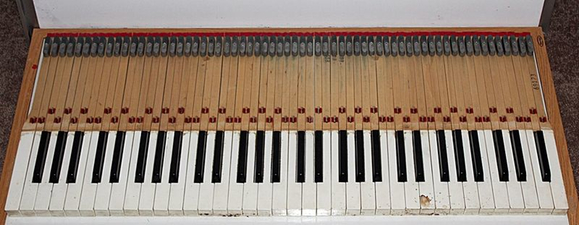
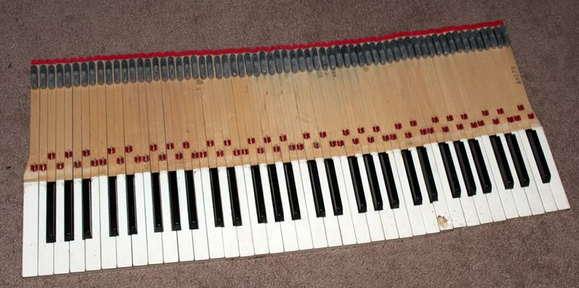
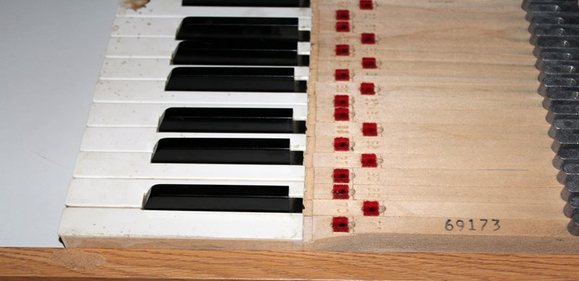
Rhodes Chroma Stack Switch Board ASSY 30-754301[item #180804060608] Sold for $40.00
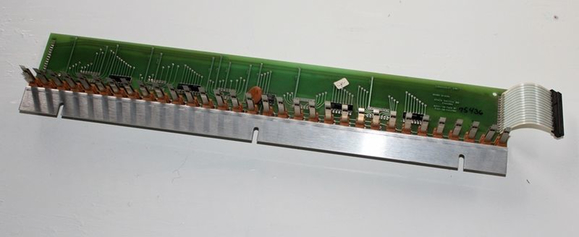

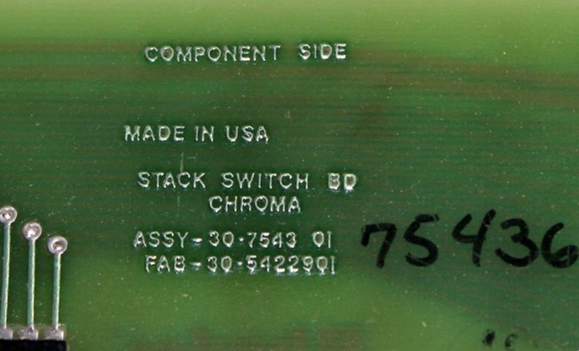
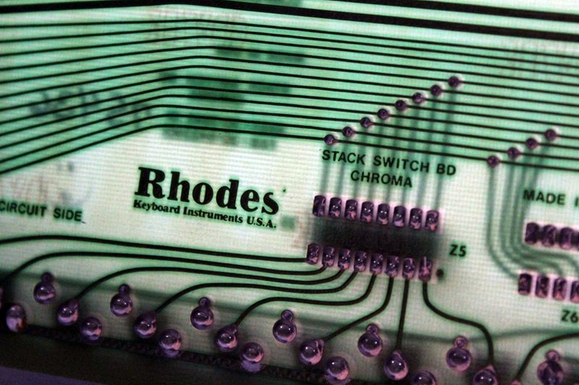
Rhodes Chroma Channel Mother BD ASSY 30-7225401 [item #180804059456] Sold for $60.00

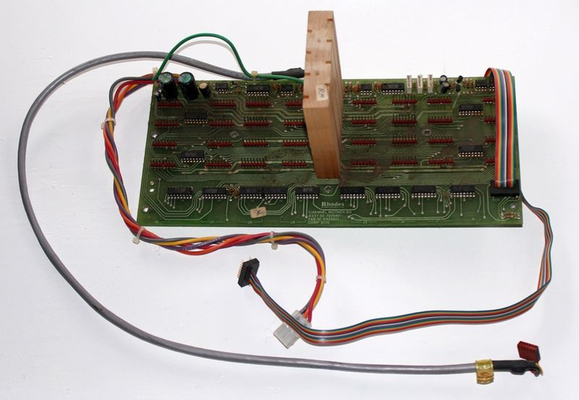
Rhodes Chroma Stack Switch Board ASSY 30-754301 [item #180804061404] Sold for $40.00

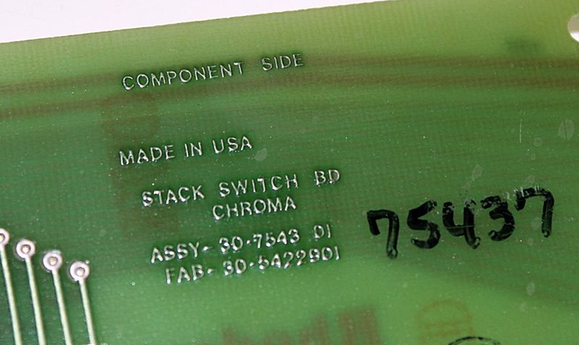
I've got to assume that somewhere there's a Chroma that these came from that'll never end up in our Registry.
Paul DeRocco [21030230] · Thu, 26 Jan 2012 20:45:16 -0800
I don't think so. I purchased the keys, and asked about other parts that may be available. I was told they just found these few things in a box in a storage room. Note that they say of one stack switch board, "This board appears to be slightly different from our other listing, perhaps a different revision." That suggests they didn't pull it out of a unit, because they are simply the left and right boards. The keys have some staining on a few of them (which is okay with me, since I don't actually need 64 spares), so I suspect that these were all malfunctioning parts that had been replaced decades ago. But that's just my theory.
Chris Ryan [21030691] · Sun, 29 Jan 2012 20:52:53 -0800
The seller writes, "My store used to be a certified service center for them way back in the day. We are currently relocating our main store to a newer facility so as we start to move we are finding all of these buried treasures so to speak. There is no telling which Chroma's these parts actually came from, they are just items found buried behind other things on our large shelves in the Tech area."
Chroma for sale in Boston area
Keith Hedger [21030607] · Thu, 26 Jan 2012 11:16:55 -0500
HI all,
I'm still trying to sell my Chroma to someone who can come pick it up in Cambridge, MA. I bought it last July for $4500. I'm asking $3500 (I need some money for a family medical emergency). The description from the ebay listing that bought it from is below. If interested please contact me at [email address removed]:
"Rhodes Chroma with CC+ AND polyphonic aftertouch,
Almost no units were shipped with the [pressure] sensor bar required. Fortunately, this one has Chris Borman's [21030194+] excellent kit installed, which takes the already impressive array of expression options to the next level.
"Of course, there was one more big drawback in the original Chroma that's fortunately solved here. When initially produced, it had no midi and frustrating single-slider dx-7-style programming. That's where the CC+ comes in.
"This Chroma was fully restored by the Good Guys in St. Paul, MN, whose reputation for fixing Chroma's is about as good as it gets. They still have guys with factory training that have been fixing these babies since they were new and work with many famous clients. The power supply was completely rebuilt and the synth functions perfectly. All voices tune up without fail. The cosmetic condition is very good, especially for its age. The tolex is in great shape with only a few minor scuffs and no tears and the wood is in great shape, though the surface finish has been worn down in places by foam rot (a notorious problem with the Chroma roadcase). It still looks good, and would look amazing with a little sanding and a few coats of finish. "
RJ Krohn [21030455] · Sun, 29 Jan 2012 08:58:23 -0700
that's a great price for that condition. you should make the rounds on the synth sites. hope you find a buyer!
Last of the CPS Kits
Chris Borman [21030194+] · Sun, 29 Jan 2012 20:09:57 -0500
Chroma Folks,
I have parts remaining to put together a few more CPS kits that I need to unload so I’m letting them go for $265. Same shipping rate: $15 USA, $30 International. It will take about a week to put the kit together. Send me an email with your location if interested.
Regards,
Chris
Chris Ryan [21030691] · Sun, 29 Jan 2012 20:28:09 -0500
Chris - by "last of the CPU kits" are you just meaning that you're cleaning up the parts you have on hand now - or does this intended to mean that there are no future CPS builds intended?
Chris Borman [21030194+] · Sun, 29 Jan 2012 21:07:35 -0500
It really comes down to PCB production cost. FSR production cost too (even more so) but I bought extra last time for the monophonic key pressure kit I am putting together for Pratt-Reed based keyboards such as Arp, Oberheim, Sequential-Circuits, etc. I have the adjustable length sensor PCB's, just need to finalize the generic controller to interface to vintage analog gear and newer MIDI keyboards by merging MIDI pressure commands into the data stream.
I have enough PCBs to build 8 more CPS Kits given none lost to attrition which can occur due to the circuit trace pitch being on the edge of the PCB manufactures capability. There are the occasional open or shorts that I can't repair. Once I run out of CPS Kit PCB's I won't be ordering anymore due to the interest has all but dried up. So this is likely the last of the CPS Kits.
Mike Jaynes [21030638+] · Sun, 29 Jan 2012 18:16:18 -0800
Hi; Chris; I would like to buy one more CPS kit.
Thanks for all your work on this, it is appreciated. Where else would we get something like this for our 30 plus year old keyboards?
Doug Wellington [21030300] · Mon, 30 Jan 2012 05:05:53 -0700
I have parts remaining to put together a few more CPS kits that I need to unload so I’m letting them go for $265.
Ouch. Guess I ordered a couple weeks too early.
Doug (life in the big city...)
Go to next message in thread, February 2012


